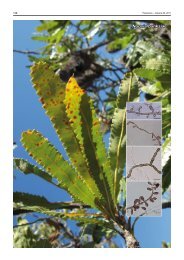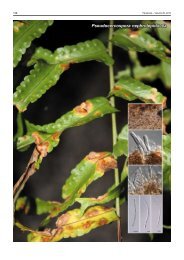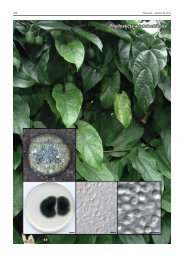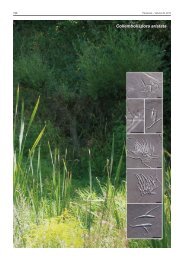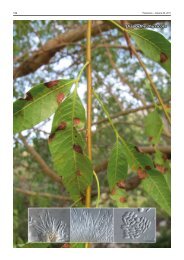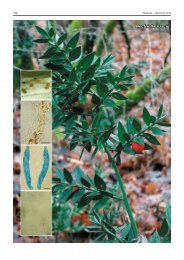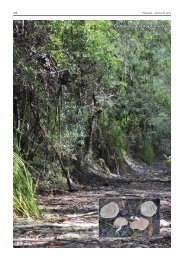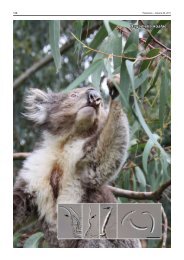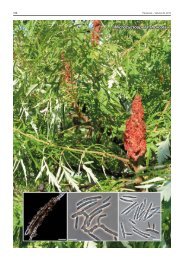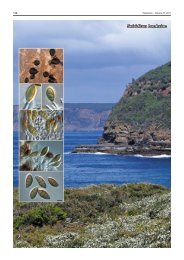Funbolia dimorpha - Fungal Planet
Funbolia dimorpha - Fungal Planet
Funbolia dimorpha - Fungal Planet
Create successful ePaper yourself
Turn your PDF publications into a flip-book with our unique Google optimized e-Paper software.
114 Persoonia – Volume 26, 2011<br />
<strong>Funbolia</strong> <strong>dimorpha</strong>
<strong>Fungal</strong> <strong>Planet</strong> description sheets<br />
115<br />
<strong>Fungal</strong> <strong>Planet</strong> 71 – 31 May 2011<br />
<strong>Funbolia</strong> Crous & Seifert, gen. nov.<br />
Spadicoidis morphologice similis, sed conidiis dimorphis, sine septis fuscatis.<br />
Etymology. Named after the <strong>Fungal</strong> Barcode of Life group that convened<br />
at Front Royal, Virginia (USA) in 2007 to initiate the CBOL <strong>Fungal</strong> Working<br />
Group.<br />
Associated with bark of a living tree. Mycelium of pale brown<br />
to hyaline, branched hyphae, giving rise to conidiophores.<br />
Conidiophores solitary, erect, straight to flexuous, cylindrical,<br />
unbranched, or branched below, brown, finely verruculose,<br />
multi-euseptate. Conidiogenous cells terminal and lateral, pale<br />
to medium brown, finely verruculose, subcylindrical to somewhat<br />
swollen, clavate to irregular; loci aggregated in a rachis,<br />
at times subdenticulate with minute collarette; scars thickened<br />
along the rim, erumpent, but not darkened nor refractive. Conidia<br />
dimorphic, medium brown, finely verruculose, ellipsoidal<br />
when 1-septate, becoming subcylindrical when multiseptate,<br />
apex obtusely rounded, tapering from basal septum to an obconically<br />
truncate hilum, not thickened, nor darkened (at times<br />
appearing to have a marginal frill); transversely euseptate.<br />
Type species. <strong>Funbolia</strong> <strong>dimorpha</strong>.<br />
MycoBank MB560161.<br />
Notes — <strong>Funbolia</strong> resembles genera such as Spadicoides<br />
(but conidia lack the darkened septa), Neta (but lacks setae),<br />
Thysanorea (but has dimorphic conidia), and Catenulisubulispora<br />
(which lacks dimorphic conidia and has beaked conidia)<br />
(Seifert et al. 2011). Because it could not be accommodated in<br />
any of the genera listed here and its DNA sequences did not<br />
match any fungi currently deposited in GenBank, we introduce<br />
a new genus here to accommodate it.<br />
<strong>Funbolia</strong> <strong>dimorpha</strong> Crous & Seifert, sp. nov.<br />
Conidiophora solitaria, erecta, ramosa vel non ramosa, subtiliter verruculosa,<br />
pluri-euseptata. Cellulae conidiogenae terminales et laterales, pallide vel<br />
medio-brunneae, subtiliter verruculosae, subcylindraceae vel leniter inflatae,<br />
clavatae vel irregulares; locis conidiogenis aggregatis in rache, interdum<br />
subdenticulatis. Conidia <strong>dimorpha</strong>, medio-brunnea, subtiliter verruculosa,<br />
conidiis 1-septatis, (6–)8–11(–20) × (4–)5 µm, et conidiis (2–)3(–7)-euseptatis,<br />
(15–)20–35(–45) × (4–)5 µm.<br />
Etymology. Named after its dimorphic conidia.<br />
Mycelium consisting of pale brown to hyaline, smooth, branched<br />
hyphae, 2–3 µm diam, becoming somewhat verruculose at<br />
fertile regions, giving rise to conidiophores. Conidiophores<br />
solitary, erect, straight to flexuous, cylindrical, unbranched, or<br />
branched below (branched conidiophores developing with age),<br />
50–100 × 3–4 µm, brown, finely verruculose, multi-euseptate,<br />
septa 5–17 µm apart, becoming somewhat darkened, but not<br />
thickened. Conidiogenous cells terminal and lateral, pale to<br />
medium brown, finely verruculose, subcylindrical to somewhat<br />
swollen, clavate to irregular, 7–20 × 2.5–5 µm; conidiogenous<br />
loci dispersed on conidiogenous cells in young cultures, aggregated<br />
in a rachis on conidiogenous cells in older cultures, at<br />
times subdenticulate with minute collarette, up to 1 µm tall, and<br />
1 µm diam; scars thickened along the rim, erumpent, but neither<br />
darkened nor refractive. Conidia dimorphic, medium brown,<br />
finely verruculose, ellipsoidal when 1-septate, (6–)8–11(–20)<br />
× (4–)5 µm, becoming subcylindrical when multiseptate, apex<br />
obtusely rounded, tapering from basal septum to an obconically<br />
truncate hilum, 1 µm diam, not thickened, nor darkened (at<br />
times appearing to have a marginal frill); (2–)3(–7)-euseptate,<br />
becoming darkened in older conidia, and also constricted at<br />
septa, (15–)20–35(–45) × (4–)5 µm; microcyclic conidiation<br />
observed in culture.<br />
Culture characteristics — (in the dark, 25 °C, after 1 mo):<br />
Colonies flat, spreading, with sparse to moderate aerial mycelium<br />
and even, lobate margins, reaching 8–10 mm diam. On<br />
potato-dextrose agar surface isabelline, reverse olivaceous; on<br />
oatmeal agar surface isabelline; on malt extract agar margin<br />
somewhat feathery, surface umber, reverse chestnut, with diffuse<br />
isabelline pigment surrounding colony.<br />
Typus. USA, Virginia, Front Royal, N 38°53'35" W 78°10'50", on blackened<br />
stem bark of unidentified tree, 14 May 2007, P.W. Crous & K.A. Seifert,<br />
holotype CBS H-20577, cultures ex-type CPC 14170 = CBS 126491, ITS sequence<br />
GenBank JF951136 and LSU sequence GenBank JF951156, Myco-<br />
Bank MB560158.<br />
Notes — Based on a megablast search of NCBI’s GenBank<br />
nucleotide database, the closest hit using the ITS sequence<br />
is Didymosphaeria futilis (GenBank EU552123; Identities<br />
= 471/552 (85 %), Gaps = 28/552 (5 %)) followed by species of<br />
Cladonia with shorter homology, e.g. Cladonia subtenuis (Gen-<br />
Bank DQ482701; Identities = 242/271 (89 %), Gaps = 8/271<br />
(3 %)). Closest hits using the LSU sequence yielded highest<br />
similarity to Heleiosa barbatula (GU479787; Identities =<br />
834/891 (94 %), Gaps = 8/891 (1 %)), Caloplaca sublobulata<br />
(EF489950; Identities = 859/947 (91 %), Gaps = 24/947 (3 %))<br />
and Caloplaca regalis (EU161240; Identities = 850/938 (91 %),<br />
Gaps = 24/938 (3 %).<br />
Colour illustrations. Blackened bark of unidentified tree at Front Royal,<br />
Virginia; conidiophores giving rise to dimorphic conidia in culture. Scale bar<br />
= 10 µm.<br />
Pedro W. Crous & Johannes Z. Groenewald, CBS-KNAW <strong>Fungal</strong> Biodiversity Centre, P.O. Box 85167, 3508 AD Utrecht, The Netherlands;<br />
e-mail: p.crous@cbs.knaw.nl & e.groenewald@cbs.knaw.nl<br />
Keith A. Seifert, Biodiversity (Mycology & Botany), Agriculture & Agri-Food Canada, 960 Carling Ave., Ottawa, Ontario, K1A 0C6, Canada;<br />
e-mail: keith.seifert@agr.gc.ca<br />
© 2011 Nationaal Herbarium Nederland & Centraalbureau voor Schimmelcultures




